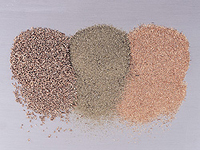●
●
●

Manufacturing Technologies

 Products
Products R&D
R&D Manufacturing Technologies
Manufacturing TechnologiesRaw Materials |
Melting |
Casting |
Extrusion |
 |
Copper is obtained from copper ore and copper scrap. Copper ore has three sorts that is copper sulfide, copper oxide and native copper. Native copper and copper sulfide are secondary products of copper sulfide, which accounts for 65% of all the copper ore.
Alomost all of copper sulfide is to be transformed into pure copper through pyroprocessing, however, copper sulfide cannot be reduced as it is. In this regard, it is to be reduced in blast furnace, reverberatory furnace or flash furnace to matte of which copper content is 30 to 50%. Subsequently, the matte is to be reduced in to crude copper of 98%Cu then finally to electrolytic copper of 99.9%Cu through electrolytic refining. |
|
Raw material of production of copper and copper alloys includes ingots such as electrolytic copper and zinc and scrap. Scrap may be, again, divided into lumps produced from manufacturing process, chips in the form of powder scattered from cutting work and waste products after use. Copper alloy industry should be basically termed recycling industry in view of the fact that such scrap is to be collected to be melted, together with electrolytic copper and zinc ingots, then to be cast; it is also a pro-environment industry from the point of view of the recent Green Round regime that globally puts a special emphasis on importance of resources recycling. In conclusion, copper alloy industry is a processing one in which coper, as main material, is melted and cast together with zinc, lead, tin, nickel, etc., as subsidiary materials, and processed via pressing, extruding, drawing, etc., to be final products including plate, tape, rod, pipe, wire, etc.
|
 |
